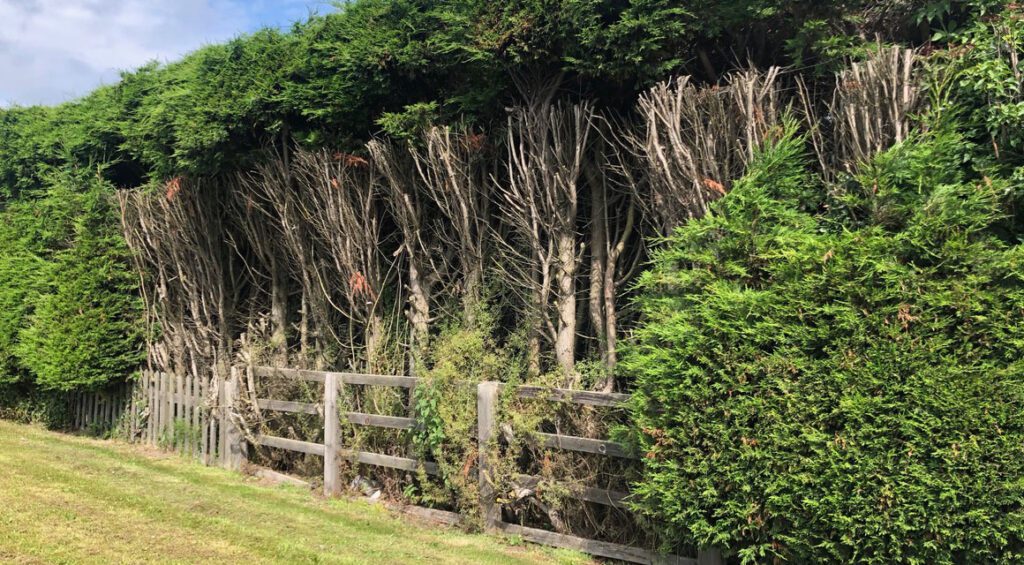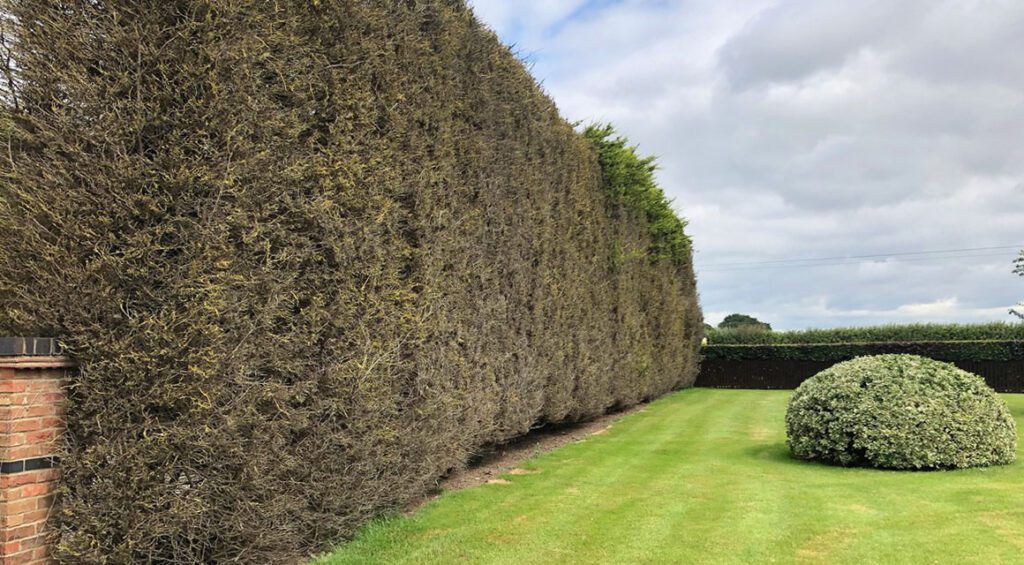There’s nothing quite as frustrating as the sudden sight of withered, brown patches in your once-glorious conifer hedge. Conifers are actually versatile trees that have a particularly strong character. But even so, your conifer hedge may suddenly not look so heart healthy. Fortunately, however, there are methods you can use to address this unpleasant problem. My conifers turn brown: what is it and what can I do about it?

Contents
Brown, bare spots due to pruning damage
Conifers are hedge plants that, in principle, can be pruned extremely well. After pruning, they can recover well and they can be pruned several times during the pruning season. Now, however, it may happen that you have pruned a conifer too radically and therefore have penetrated into the old wood. This can cause bare spots that the plant itself can no longer compensate for. But there is a simple solution to this problem, because the plant still has enough pretty green branches growing around these spots. In fact, these green branches can help you to fill in the bare spots quite easily: carefully bend the branches over the bare spots and secure them in a loose way with a piece of wire or with a tie-wrap or cable tie. Do not clamp the branches too tightly. As soon as the conifer hedge starts to grow new shoots again, then with your help the green branches will then also automatically grow in the direction of these bare spots, i.e. in the right direction. In this way, your hedge will look wonderful again after a year! Also remember that your conifer hedge should be well fertilized after radical pruning. Indeed, fertilizing also supports the regeneration of a plant. Read more about fertilizing and watering your hedge here!

Brown conifers due to prolonged drought
There are long periods of drought, especially in the summer, when hardly any rain falls from the sky. Your conifer hedge can react to this by becoming dried out and brown. Sometimes conifers even turn brown altogether due to drought. The good news, however, is that in most cases, conifers that have turned brown from prolonged drought can also recover beautifully. However, once a conifer has completely dried out, it’s hard to get around to watering it. Spraying the conifer with water then also serves no purpose: the conifer then really needs a lot more. Look carefully at which trees in your hedge have turned brown and dig a small gutter around the trunk of these plants, which you then fill with water. This way the water won’t just evaporate on the dry soil, it will actually reach the root ball. It is recommended to provide your conifer hedge with extra water during a dry spell by immediately watering the root ball. Your entire hedge should also be provided with extra fertilizer: this will again stimulate the regeneration process. When it comes to pruning your conifer hedge, then read more about pruning conifers down to the old wood here.
Magnesium deficiency in the soil
Sometimes conifers turn brown because there is a magnesium deficiency in the garden soil in which grows the conifer hedge, which they previously planted. The brown spots look particularly unsightly and they are mainly located on the underside and in the middle of affected plants. You can buy magnesium in fertilizer form from garden centers and an online web store. Read the package insert before use. The package insert will state the exact dosage your conifer hedge needs. It also states how you should best administer the magnesium to your conifers. In some cases, the fertilizer is administered in the form of mineral grains. You then sprinkle these grains along the entire length of the hedge. You should then also use a garden rake to mix these grains very lightly with the garden soil. If you fertilize your hedge well every year in the spring, then this way you can avoid your hedge not getting enough minerals and nutrients. If you provide your hedge with a basic fertilizer every year in the spring, then you can also give it the necessary magnesium at the same time.

Discolored conifers due to mold diseases
Certain varieties of conifers can get mold diseases. For example, consider the Thuja, the Taxus, and the Leyland Cypress. If your conifer hedge has a mold infection, branch death is a clear characteristic and a distinct difference between attacked and unattacked portions of the hedge. It is then necessary to cut off attacked parts as soon as possible. Make sure that after cutting you disinfect the pruning tools with a chlorine solution or with water containing some bleach. This way, you can prevent the mold from spreading to the rest of your hedge. Do you wear gloves while cutting? Wash your gloves at least 60 degrees after pruning, just like the rest of your garden clothes.
Fortunately, mildew diseases of conifers are generally easy to control. Several remedies for mold diseases are available from garden centers. These remedies are called fungicides. Check with your local garden center for the most appropriate remedy for conifers. To prevent mold in your conifer hedge, it is also important that you prune the hedge in a way that allows the inside of the hedge to get sunlight as well. You do this by allowing the bottom half of the conifers to grow wider than the top half. Then, after a rainstorm or wet weather, the hedge will dry much faster. This in turn ensures that the hedge is also less susceptible to mold disease.
Avoid brown conifers
The good news is that your conifer hedge won’t turn brown anytime soon. After all, conifers are particularly vigorous trees that can also grow decidedly old. Any problems that may arise are relatively easy to solve. You can prevent your hedge from turning brown by pruning your conifers every year and then fertilizing them, preferably in the spring. By doing this, you will give the garden soil nutrients and minerals that your conifers also desperately need. Conifers otherwise do not need any special care to remain permanently beautiful. That is why the conifer is such a popular evergreen hedge plant among garden lovers!

